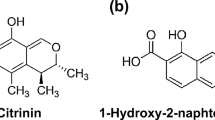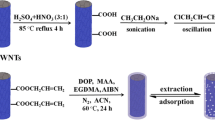Abstract
A molecularly imprinted polymer (MIP) for the selective solid-phase extraction (SPE) was prepared using fenvalerate (FEN) as template and pyrrole as monomer. For comparison, non-imprinted polymer (NIP) was synthesized in the absence of FEN. A molecularly imprinted solid-phase extraction (MISPE) procedures were performed in column method by florescence detection technique. High-performance liquid chromatography (HPLC) analysis using a C18 column (300 mm × 3.9 mm, 5 μm), acetonitrile/water (1:1 v/v) as the mobile phase at a flow rate of 1.5 mL min−1 was applied for the quantitative determination. The parameters that affect the efficiency of method were thoroughly investigated. The measurements were done under the optimal conditions. The influence of desorption solvent, amount of sorbent, pH, and ionic strength were investigated. The limit of detection (LOD) and limit of quantification (LOQ) of method were obtained as 0.19 and 0.63 ng g−1, respectively. The relative standard deviation of standard solution (RSD%) was obtained 4.07 %. The application of method to separation and preconcentration of FEN in food samples were examined. The minimum and maximum recovery (%) through the spiking 50 ng of FEN per gram of samples was obtained as 85.30 and 96.50, respectively.

ᅟ












Similar content being viewed by others
References
Altorshani AA, Bakar NKA, Eid EEM (2010) Validated high performance liquid chromatographic method for analysis of fenvalerate pesticide in chilies by QuEChERS extraction cleanup and high liquid chromatography. Am J Appl Sci 7:1587–1592
Ansari R, Feizy J, Fallah Dellavar A (2008) Removal of arsenic ions from aqueous solutions using conducting polymers. Eur J Chem 5(4):853–863
Bidan G, Divisia-Blohorn B, Lapkowski M, Kern JM, Sauvage JP (1992) Electroactive films of polypyrroles containing complexing cavities performed by entwining ligands on metallic centers. J Am Chem Soc 114:5986–5994
Brezoi DV (2010) Polypyrrole films prepared by chemical oxidation of pyrrole in aqueous FeCl3 solutions. J Sci Arts 1(12):53–58
Caro E, Marce RM, Cormack PAG, Sherrington DC, Borrull F (2003) On-line solid-phase extraction with molecularly imprinted polymers to selectively extract substituted 4-chlorophenols and 4-nitrophenol from water. J Chromatogr A 995(1–2):233–238
Chen ZM, Wang YH (1996) Chromatographic methods for the determination of pyrethrin and pyrethroid pesticide residue in crops, foods and environmental samples. J Chromatogr A 754:367–395
Claudio B, Laura A, Cristina G (2008) Molecular imprinted polymers as synthetic receptors for the analysis of myco- and phyco-toxins. Analyst 133:719–730
Dai C, Zhou X, Zhang Y, Liu S, Zhang J (2011) Synthesis by precipitation polymerization of molecularly imprinted polymer for the selective extraction of diclofenac from water samples. J Hazard Mater 198:175–181
Dell’Oro D, Casamassima F, Gesualdo G, Iammarino M, Mambelli P, Nardelli V (2014) Determination of pyrethroids in chicken egg samples: development and validation of a confirmatory analytical method by gas chromatography/mass spectrometry. Int J Food Sci Technol 49:1391–1400
Diaz-Alvarez M, Turiel E, Martín-Esteban A (2009) Selective sample preparation for the analysis of (fluoro)quinolones in baby food: molecularly imprinted polymers versus anion-exchange resins. Anal Bioanal Chem 393(3):899–905
Eisazadeh H (2007) Studying the characteristics of polypyrrole and its composites. World J Chem 2(2):67–74
European food safety authority, scientific support for preparing an EU position for the 45th Session of the Codex Committee on Pesticide Residues (CCPR). (2013), 11(7):3312
Galera MM, Martínez Vidal JL, GarridoFrenich A, García MDG (1996) Determination of cypermethrin, fenvalerate and cis- and trans-permethrin in soil and groundwater by high-performance liquid chromatography using partial least-squares regression. J Chromatogr A 727(1):39–46
Hadizadeh F, Hassanpour Moghadam M, Mohajeri SA (2013) Application of molecularly imprinted hydrogel for the preparation of lactose-free milk. J Sci Food Agric 93(2):304–309
Haginaka J, Sanbe H (2001) Uniformly sized molecularly imprinted polymer for (S)-naproxen-retention and molecular recognition properties in aqueous mobile phase. J Chromatogr A 913(1–2):141–146
Jesus Garcia-Galan M, Silvia Diaz-Cruz M, Barcelo D (2010) Determination of triazines and their metabolites in environmental samples using molecularly imprinted polymer extraction, pressurized liquid extraction and LC–tandem mass spectrometry. J Hydrol 383:30–38
Jonsson JA, Mathiasson L (2001) Membrane extraction in analytical chemistry. J Sep Sci 24(7):495–507
Jureviciute I, Bruckenstein S (2003) Electrochemical activity of chemically deposited polypyrrole films. J Solid State Electrochem 7:554–560
Lanza F, Hall AJ, Sellergren B, Bereczki A, Horvai G, Bayoudh S, Cormack PAG, Sherrington DC (2001) Development of a semi-automated procedure for the synthesis and evaluation of molecularly imprinted polymers applied to the search for functional monomers for phenytoin and nifedipine. Anal Chim Acta 435:91–106
Lasakova M, Jandera P (2009) Molecularly imprinted polymers and their application in solid phase extraction. J Sep Sci 32:799–812
Madden J, Cush R, Kanigan T, Brenan CJH, Hunter IW (1999) Encapsulated polypyrrole actuators. Synth Met 105:61–64
Maouche N, Guergouri M, Gam-Derouich S, Jouini M, Nessark B, Chehimi MM (2012) Molecularly imprinted polypyrrole films: some key parameters for electrochemical picomolar detection of dopamine. J Electroanal Chem 685:21–27
Martin PD, Jones GR, Stringer F, Wilson ID (2003) Comparison of normal and reversed-phase solid phase extraction methods for extraction of β-blockers from plasma using molecularly imprinted polymers. Analyst 128(4):345–350
Masuda H, Asanov DK (2003) Preparation and properties of polypyrrole. Synth Met 135–136:43–44
Mayes AG, Andersson LI, Mosbach K (1994) Sugar binding polymers showing high anomeric and epimeric discrimination obtained by noncovalent molecular imprinting. Anal Biochem 222(2):483–488
Mehdinia A, Aziz-Zanjani MO, Ahmadifar M, Jabbari A (2013) Design and synthesis of molecularly imprinted polypyrrole based on nanoreactor SBA-15 for recognition of ascorbic acid. Biosens Bioelectron 39:88–93
Miah M, Iqbal Z, Lai EPC (2012) Rapid in-capillary CE-UV binding tests of endocrine disrupting compounds and pharmaceuticals with polypyrrole-coated magnetic nanoparticles. Anal Methods 4(9):2866–2878
Miah M, Iqbal Z, Lai EPC (2014) A comparative CE-UV binding tests study between polydopamine-coated and polypyrrole-coated magnetic nanoparticles with endocrine disrupting compounds and pharmaceuticals in water. Clean Soil Air Water. doi:10.1002/clen.201300210
Mijangos I, Navarro-Villoslada F, Guerreiro A, Piletska EV, Chianella I, Karim K, Turner APF, Piletsky SA (2006) Influence of initiator and different polymerisation conditions on performance of molecularly imprinted polymers. Biosens Bioelectron 22(3):381–387
Nezhadali A, Mojarrab M (2014) Computational study and multivariate optimization of hydrochlorothiazide analysis using molecularly imprinted polymer electrochemical sensor based on carbon nanotube/polypyrrole film. Sensor Actuators B Chem 190:829–837
Nezhadali A, Ahmadi Bonakdar G, Nakhaei H (2012) Electrosynthesis of polypyrrole on steel fiber for solid-phase microextraction of citalopram in serum. Anal Bioanal Chem 403(2):593–600
Okuno H, Kitano T, Yakabe H, Kishimoto M, Deore BA, Siigi H, Nagaoka T (2002) Characterization of overoxidized polypyrrole colloids imprinted with L-lactate and their application to enantioseparation of amino acids. Anal Chem 74:4184–4190
Pardieu E, Cheap H, Vedrine C, Lazerges M, Lattach Y, Garnier F, Remita S, Pernelle C (2009) Molecularly imprinted conducting polymer based electrochemical sensor for detection of atrazine. Anal Chim Acta 649:236–245
Park DP, Sung JH, Lim ST, Choi HJ, Jhon MS (2003) Synthesis and characterization of organically soluble polypyrrole/clay nanocomposites. J Mater Sci Lett 22(18):1299–1302
Pichon V (2007) Selective sample treatment using molecularly imprinted polymers. J Chromatogr A 1152(1–2):41–53
Pichon V, Chapuis-Hugon F (2008) Role of molecularly imprinted polymers for selective determination of environmental pollutants—a review. Anal Chim Acta 622(1–2):48–61
Piletsky SA, Piletska EV, Karim K, Freebairn KW, Legge CH, Turner APF (2002) Polymer cookery: influence of polymerization conditions on the performance of molecularly imprinted polymers. Macromolecules 35(19):7499–7504
Piletsky SA, Guerreiro A, Piletska EV, Chianella I, Karim K, Turner APF (2004) Polymer cookery 2. Influence of polymerization pressure and polymer swelling on the performance of molecularly imprinted polymers. Macromolecules 37(13):5018–5022
Piletsky SA, Mijangos I, Guerreiro A, Piletska EV, Chianella I, Karim K, Turner APF (2005) Polymer cookery: influence of polymerization time and different initiation conditions on performance of molecularly imprinted polymers. Macromolecules 38(4):1410–1414
RamamohanaRao C, Arun Kumar C (2012) Qualitative and quantitative analysis of fenvalerate and methyl parathion pesticides in mango and grapes collected by HPLC method. IJSIT 1(1):56–58
Ratautaite V, Janssens SD, Haenen K, Nesládek M, Ramanaviciene A, Baleviciute I, Ramanavicius A (2014) Molecularly imprinted polypyrrole based impedimentric sensor for theophylline determination. Electrochim Acta 130:361–367
Sadeghi S, Jahani M (2013) Selective solid-phase extraction using molecular imprinted polymer sorbent for the analysis of florfenicol in food samples. Food Chem 141(2):1242–1251
Sahebnasagh A, Karimi G, Mohajeri SA (2014) Preparation and evaluation of histamine imprinted polymer as a selective sorbent in molecularly imprinted solid-phase extraction coupled with high performance liquid chromatography analysis in canned fish. Food Anal Methods 7(1):1–8
San Vicente B, Navarro Villoslada F, Moreno-Bondi MC (2004) Application of multivariate analysis to the screening of molecularly imprinted polymers for bisphenol-A. Anal Chim Acta 504:149–162
Sellergren B (1994) Direct drug determination by selective sample enrichment on an imprinted polymer. Anal Chem 66:1578–1582
Shaabani N, Javanbakht M, Safaraliee L, Eynollahi S (2010) Solid-phase extraction and determination of metoclopramide in biological fluids and human urine by molecularly imprinted polymers. J Sci I A U (JSIAU) 20(76):69–78
Sharma A, Gupta M, Shanker A (2008) Chromatographic methods for determination of fenvalerate residues in crops. Indian J Appl Entomol 22(2):167–178
Shi X, Liu J, Sun A, Li D, Chen J (2012) Group-selective enrichment and determination of pyrethroid insecticides in aquaculture seawater via molecularly imprinted solid phase extraction coupled with gas chromatography-electron capture detection. J Chromatogr A 1227:60–66
Shiigi H, Yakabe H, Kishimoto M, Kijima D, Zhang YA, Sree U, Deore BA, Nagaoka T (2003) Molecularly imprinted overoxidized polypyrrole colloids: promising materials for molecular recognition. Microchim Acta 143:155–162
Shima Batlokwa B, Mokgadi J, Nyokong T, Torto N (2010) Optimal template removal from molecularly imprinted polymers by pressurized hot water extraction. Chromatographia 73:589–593
Shinger MI, Elbashir AA, Ahmed HA, Aboul-Enein HY (2012) Simultaneous determination of cypermethrin and fenvalerate residue in tomato by gas chromatography and their applications to kinetics studies after field treatment. Biomed Chromatogr 26(5):589–593
Sipho EM, Gerald FM, David EM, Emmanuel II (2010) Physicochemical and morphological properties of poly(aniline-co-pyrrole). J Mater Sci 45:3325–3330
Tagami T, Kajimura K, Yamasaki K, Sawabe Y, Nomura C, Taguchi S, Obana H (2009) Simple and rapid determination of cypermethrin and fenvalerate residues in kampoproducts by gas chromatography–mass spectrometry with negative chemical ionization. J Health Sci 55(5):777–782
Tamayo FG, Martin-Esteban A (2005) Selective high performance liquid chromatography imprinted-stationary phases for the screening of phenylurea herbicides in vegetable samples. J Chromatogr A 1098(1–2):116–1122
Tamayo FG, Casillas JL, Martin-Esteban A (2003) Highly selective fenuron-imprinted polymer with a homogeneous binding site distribution prepared by precipitation polymerisation and its application to the clean-up of fenuron in plant samples. Anal Chim Acta 482:165–173
Turiel E, Martin-Esteban A (2010) Molecularly imprinted polymers for sample preparation: a review. Anal Chim Acta 668:87–99
Turiel E, Tadeo JL, Cormack PAG, Martin-Esteban A (2005) HPLC imprinted-stationary phase prepared by precipitation polymerisation for the determination of thiabendazole in fruit. Analyst 130:1601–1607
Wang J, Guo R, Chen J, Zhang Q, Liang X (2005) Phenylurea herbicides-selective polymer prepared by molecular imprinting using N-(4-isopropylphenyl)-N′-butyleneurea as dummy template. Anal Chim Acta 540:307–315
Zhou Q, Zhang X, Xie G (2011) Preconcentration and determination of pyrethroid insecticides in water with ionic liquid dispersive liquid-phase microextraction in combination with high performance liquid chromatography. Anal Methods 3:356–361
Conflict of Interest
Azizollah Nezhadali declares that he has no conflict of interest. Javad Feizy declares that he has no conflict of interest. Hamed Reza Beheshti declares that he has no conflict of interest. This article does not contain any studies with human or animal subjects.
Author information
Authors and Affiliations
Corresponding author
Additional information
Highlights
Chemical PPy-MIP for FEN analysis was synthesized.
The MIP was successfully used in MISPE method.
MIP has been applied for the determination of FEN in food samples.
Rights and permissions
About this article
Cite this article
Nezhadali, A., Feizy, J. & Beheshti, H.R. A Molecularly Imprinted Polymer for the Selective Extraction and Determination of Fenvalerate from Food Samples Using High-Performance Liquid Chromatography. Food Anal. Methods 8, 1225–1237 (2015). https://doi.org/10.1007/s12161-014-0004-7
Received:
Accepted:
Published:
Issue Date:
DOI: https://doi.org/10.1007/s12161-014-0004-7




